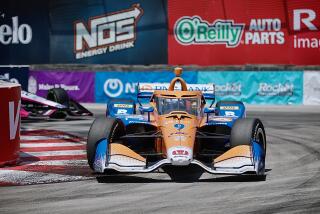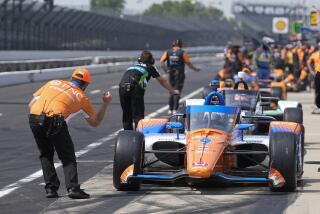Engines Can’t Always Be Judged by the Cover
Much has been said about the lack of American involvement in CART’s champ car series.
Only two American-born drivers--Jimmy Vasser and Michael Andretti--are competing this year, both of the chassis’ manufacturers are English companies, and three of the four engines used carry the names of foreign passenger-car manufacturers.
But appearances can be deceiving.
Auto manufacturers have long engaged in the so-called practice of “badging,” which is sticking a name and logo on a racing engine as an extension of the “Win on Sunday, sell on Monday” marketing philosophy.
Ford, the one engine manufacturer with a name that is universally associated with the United States, provides nothing more than name and logo to British-based Cosworth. Although Ford did buy Cosworth last September, and the engines used in the CART series are assembled in Torrance, most of the operation still takes place in England.
The Ilmor engine that carries the Mercedes name used to carry the Chevrolet name but has always been built in England.
Turning things around, Toyota and Honda, names associated with Japanese cars, both have their CART racing-engine programs in the Southland. Both companies design and assemble their power plants here, although Honda makes more use of the parent company in Japan.
Honda Performance Development, a subsidiary of American Honda Motor Company, calls Santa Clarita home. Costa Mesa is the home base for Toyota Racing Development, a wholly-owned subsidiary of Toyota Motor Sales USA.
According to Lee White, Toyota racing group vice president and general manager, and Robert Clarke, Honda performance general manager, both companies use the technology advances made in racing in their passenger-car operations.
There is one striking difference, however. Honda has been the dominant engine in CART for several years. Toyota has yet to win a race.
“Toyota had an opportunity in 1993 to acquire Ilmor and be an instant winner by badging,” said White, who was general manager of Jack Roush’s NASCAR operation for six years and served in the same capacity for the Newman-Haas CART team owned for two years before joining Toyota in 1998.
“Toyota made a conscious decision not to do that. Up until this year, our focus has been on building the infrastructure to become a racing company.”
Both companies have new engines this year, that are lighter and smaller but produce more power than previous models.
White said Toyota’s CART engine program operates largely on its own, although monthly meetings are held with the parent company.
“The engine we are building now was totally designed here,” he said. “We use our associates in Japan as an engineering resource to test things like metallurgy, because they have some equipment that we don’t have. The people in Japan did not touch our new design for one year.”
Clarke estimated that 80% of the resources used in Honda’s CART program come from Japan, the rest from the Santa Clarita facility and various local purveyors. He added, however, that Honda’s goal is to “reverse those numbers.”
Toyota scored a major coup this year when car owner Chip Ganassi, whose drivers have won the last four CART championships in Honda-powered cars, shocked the racing world by switching to Toyota.
Former champion Jimmy Vasser showed that the new Toyota engine can be competitive by driving one of Ganassi’s Lolas to a fourth-place finish in the season-opener at Homestead, Fla.
According to Clarke, 72 people work in the CART engine program at Honda’s Santa Clarita facility. White said Toyota employs 160 people at Costa Mesa.
Besides the success curve, the biggest difference between Honda and Toyota is in the companies’ attitudes toward the Indianapolis 500, sanctioned by CART’s open-wheel rival, the Indy Racing League.
Clarke acknowledged that Honda did not want its CART teams running in the 500, which requires the use of Nissan or Oldsmobile engines.
“We felt that by participating in the Indy 500, the teams were endorsing the philosophies of the IRL,” Clarke said. “What we told our teams is that we don’t think they should endorse the philosophy of the IRL without the full endorsement of CART.”
Ganassi has entered Vasser and defending CART champion Juan Montoya in this year’s 500--they will be the only CART drivers there--with Toyota’s full blessing.
“We hope and pray that when Chip goes there, that it’s not a detraction from his CART team,” White said. “We trust him on that.
“We would love to have the Indy 500 winner driving our car, and if Chip wins, I would say that the other manufacturers would have to reconsider their decision [to not participate].”
(BEGIN TEXT OF INFOBOX / INFOGRAPHIC)
The Engines
What engines are being used in Sunday’s Long Beach Grand Prix:
Engine No.
Ford 10
Toyota 5
Honda 5
Mercedes 5






